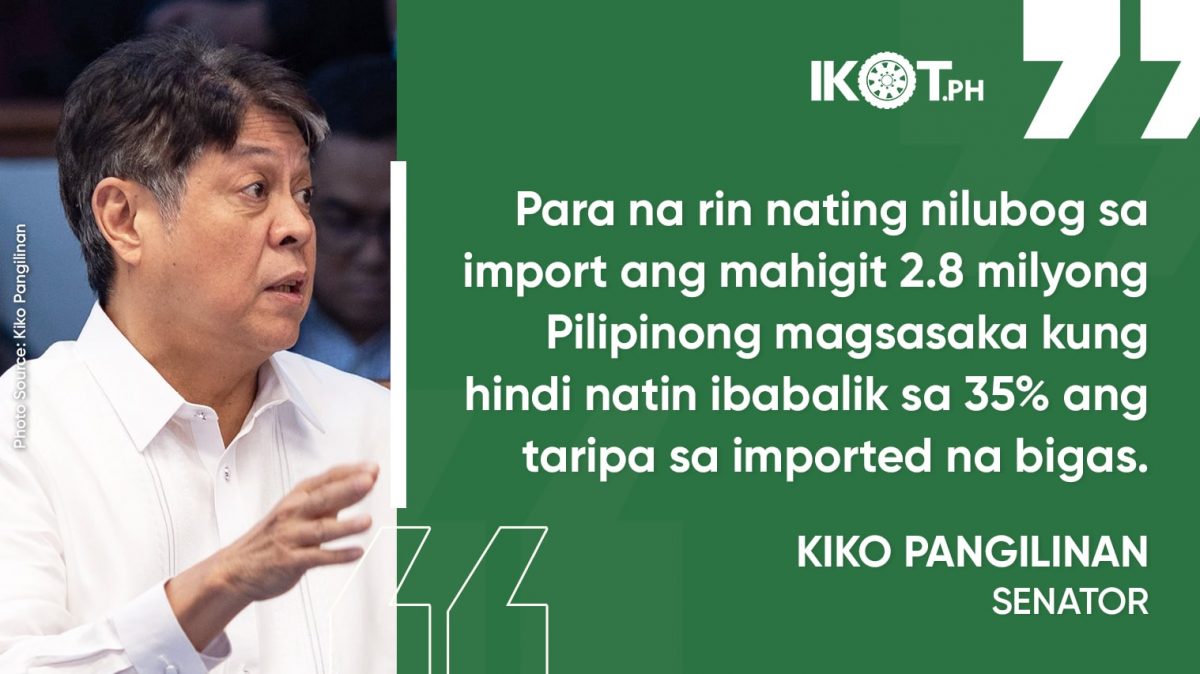Through the leadership of Senator Kiko Pangilinan, the Senate adopted Resolution No. 29 urging Malacañang to revert the tariff rate on imported rice to 35% from the current 15% to reduce revenue losses of farmers, empower local rice producers, and bring down the prices of rice in the domestic market.
Signed by both Pangilinan and Senator Migz Zubiri and with zero objections during the plenary session, the resolution seeks to “urgently request” the executive to reinstate the most favored nation (MFN) tariff rate on imported rice back to 35%.
In his privilege speech, Pangilinan lamented that the 60-day importation ban on rice will soon end, and farmers will yet again face the grueling reality of competing with the prices of imported rice.
“Mr. President, ngayon ang 31st day ng timeout. Lahat ay naghihintay. Gutom para sa isang tunay na solusyon,” the veteran legislator said.
“Mababa ang taripa, mababa ang presyo ng bigas sa world market, ang laki ng kita ng mga importer.”
“Panahon na para itaas ang taripa, ibalik sa 35% dahil ang laki ng kinikita. Mababa ang taripa, mababa ang presyo ng bigas sa world market, ang laki ng kita ng mga importer,” the seasoned lawmaker added, after citing recent data that the price of rice in the world market went down by 40%–from $700 per metric ton last year to $376 per metric ton this year.
The senator, who chairs the Senate Committee on Agriculture, Food, and Agrarian Reform, underscored the need for a higher tariff rate on imported rice, pointing out its benefits to rice farmers and consumers.
Under the proposed resolution, Pangilinan and Zubiri said that bringing back the tariff rate to 35% would:
– Strengthen domestic rice production by narrowing the gap between farmgate prices and production costs
– Restore government revenue that could amount to some P47.65 billion annually if tariff rate is at 35%
– Address the contraction of agricultural employment by supporting the local sector
– Rebalance the distribution of tariff policy benefits to ensure equitable gains for consumers, producers, and government
Through Executive Order No. 62 last year, the tariff rate on imported rice was brought down to 15% to lower market prices of rice for consumers.
But Pangilinan pointed out that the move led to a drop in the farmgate price of palay (unhusked rice) to just an average of P7.66 per kilo, way below the production cost of P13.51 per kilo.
“Ang talo: gobyerno.”
“Ang panalo? Mga importer at trader, na ibinulsa ang difference ng seven pesos at less than one peso kada kilo. Ang mga talunan? Mga magpapalay at pati na rin ang ating mga mamimili,” he said. “Ang talo: gobyerno.”
Pangilian explained that in the four months since EO 62 was signed, government revenue from tariffs went down by P9.24 billion. In a year, the government lost P27 billion, which could have been used to augment the Rice Competitiveness Enhancement Fund (RCEF) meant to provide financial and logistical assistance to farmers.
“Para na rin nating nilubog sa import ang mahigit 2.8 milyong Pilipinong magsasaka kung hindi natin ibabalik sa 35% ang taripa sa imported na bigas,” he added.
Aside from imposing the 35% tariff rate on imported rice, Pangilinan is also seeking President Ferdinand Marcos Jr.’s support on a number of key measures to boost the agricultural sector–the creation of the Congressional Commission on Agriculture, Fisheries, and Food Security (AGRICOM) Act, the full implementation of the Sagip Saka Act, the passage of the agricultural cooperatives, extension services, and agricultural land conversion ban laws, and the amendments to the Rice Tariffication Law (RTL).



